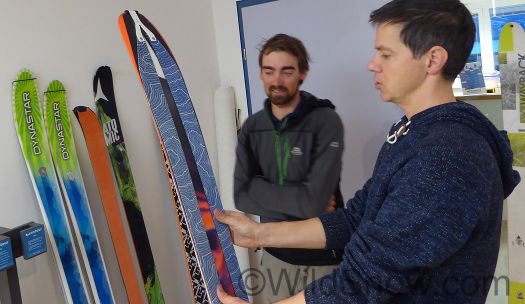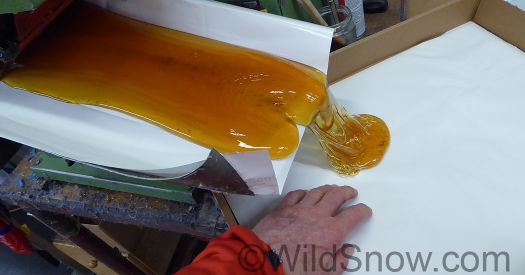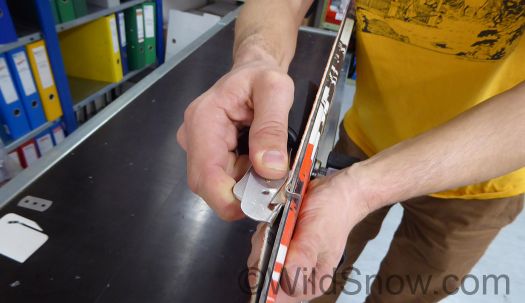One of my favorite “industry visits” here in the old country is when we sit down (and stand up and ski) with Werner Koch of Koch Alpin. These Austrian “goat hair dealers” (I jest) make what in my opinion is the Tesla of ski climbing skins, Contour Hybrid, along with a few other products they’re involved in manufacturing or distributing. We’ve covered these guys quite a bit, see previous Contour blog posts.
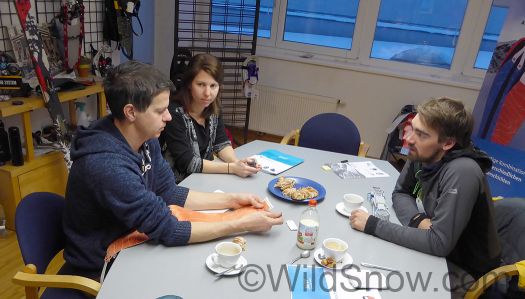
Louie chats up Werner and his employee Doris, they’re looking at Contour’s excellent ski tip loop attachment.
In skins, this year at Koch is one of consolidation and improvement of existing products. Werner related that they’ve been able to outsource the manufacturing of their Hybrid skin fabric, allowing them to concentrate on cutting pre-cut skins and doing a good job with their tip-tail fix systems. For those of you who didn’t see our blog posts of yore, quickly summarized: the Contour Hybrid glue system uses a special bonding layer that allows the use of more user-friendly skin glue on the exposed adhesive side of the skin. The Hybrid adhesive sticks to itself quite gently so getting your skins apart after storage isn’t a shoulder ripping struggle, and it can be easily cleaned with wax remover. Contour Hybrid glue is not “super sticky” like you’d want for 30 below zero interior Canada, but for 90% of touring conditions it’s perfect. We’re big fans of the stuff.
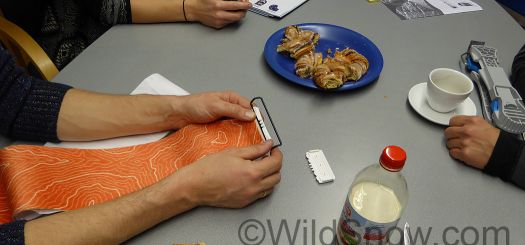
Vario skin tip clip, can be used over and over again as it attaches as a clamshell with two tiny catches.
We in particular like how Contour Hybrid adhesive works for split skins. Contour will continue making their Hybrid Free split using their 70% mohair mix plush. This pre-cut split skin works for a variety of ski widths down to about 95 mm, perfect if you have a quiver of fatties and don’t want to run a set of skins for each and every plank.
In other news at Contour: They’re using a stiffer and stronger plastic in their excellent Vario Clip ski tip skin anchor. Apparently some folks were so aggressively ripping skins that the clip would flex and come apart. Werner keeps increasing the number of ski makers he cuts skins for, and this year he added a branded skin with stunning graphics for one well known company we can’t name until ISPO in a few days. For those of you who like the traditional hotmelt glue, the Contour 70% mohair and 100% mohair fur will continue with various tip and tail anchors.
We had our usual fun and informative convo with Werner. Of note, he said the challenging thing about mohair is that every year this natural hair product varies in performance due to the climate, food and animal health. What is more, depending on which part of the animal the fur was shorne from, you get various differences. Some years the skins will have more glide, some years more durability, and so on. In other words, natural wool climbing skins have “vintages” just like wine. Takeaway: If you buy mohair skins off a roll at your favorite ski shop, and they perform well, it’s advisable to get a second set off that same roll. “Check out my 2012 vintage mohairs, some of the best glide ever!”
We also discussed the cost of climbing skins vs wear. Americans, he said, are known in the industry for expecting their ski gear to virtually last forever — even though it clearly does not. Europeans heavy users who ski tour around 100 days a season, however, know they’ll be replacing their skins every one or two seasons and don’t balk at the expense any more than they balk at keeping good tires on their bicycles. It’s too bad climbing skins (especially mohair) are not more bullet proof, but weight and glide are important. At this juncture we have to accept reality.
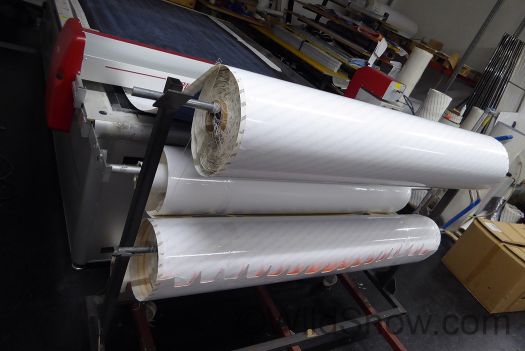
The Contour Hybrid skin material comes in rolls, then gets shaped on a computer controlled cutting table.
Contour climbing skins will continue to be distrubted by CAMP USA in North America, available at specialty retailers and etailers such as Cripple Creek Backcountry and Skimo.com
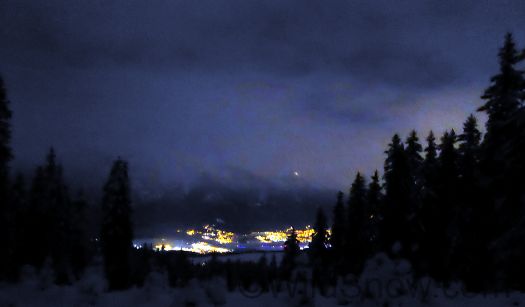
During our meetings with Contour we usually do an evening uphill ski, then dinner. This delightful view of Innsbruck illustrated the walk, topped by an excellent Tyrolean schnitzel, (which is what I call wiener schnitzel made in the Tirol, apologies to Vienna).
WildSnow.com publisher emeritus and founder Lou (Louis Dawson) has a 50+ years career in climbing, backcountry skiing and ski mountaineering. He was the first person in history to ski down all 54 Colorado 14,000-foot peaks, has authored numerous books about about backcountry skiing, and has skied from the summit of Denali in Alaska, North America’s highest mountain.

